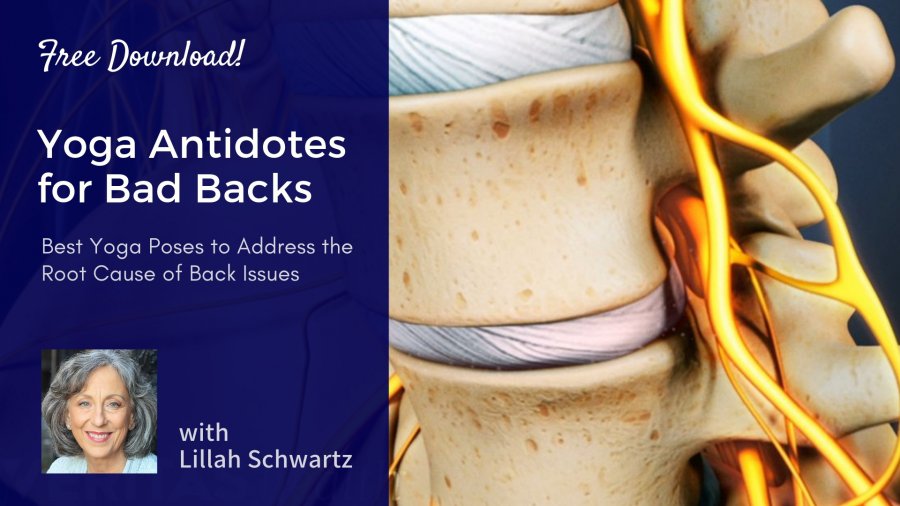Free Download! Yoga Antidotes for Bad Backs—Best Yoga Poses to Address the Root Cause of Back Issues
Course Info
- Price:
- $0.00
Lillah Schwartz
 Lillah Schwartz, C-IAYT Certified Yoga Therapist, E-RYT 500, is an Asheville-based yoga teacher, teacher trainer, and author, with more than 40 years of experience. She shares with students what she has learned from years of study with master yoga teachers, along with ongoing exploration about...
Lillah Schwartz, C-IAYT Certified Yoga Therapist, E-RYT 500, is an Asheville-based yoga teacher, teacher trainer, and author, with more than 40 years of experience. She shares with students what she has learned from years of study with master yoga teachers, along with ongoing exploration about... 
Some 80% of the adult population will experience low back pain at one point. And with lifestyles increasingly involving long hours of sitting and bad postural habits, the problem is getting worse, not better.
The good news is that the movement of yoga can restore healthy movement and wake up a system that is sluggish from poor postural habits and too much sitting.
In this free download, yoga therapist Lillah Schwartz draws on her three decades of experience with how we can use yoga to prevent and relieve back issues stemming from even long-standing issues.
Lillah notes how spending long stretches sitting without taking breaks for movement can collapse the lumbar curve and cause the vertebrae to start to shift, resulting in disc compression, reduced space for the nerves, and collapse in the chest. The weight of the chest can then actually start to sit on the diaphragm, interfering with the movement of breath.
“The next thing we know, our brains are not functioning well because we're not getting enough oxygen. If I'm at the computer for more than an hour, all of a sudden, I’ll notice that my productivity has really slowed down and I'm not thinking really clearly,” Lillah notes. “That’s when it’s time to stand up and move.”
The #1 key to keeping the spine healthy, Lillah notes, is movement. All structures of the spine depend on movement to stay healthy, in particular the intervertebral discs. As an illustration of the critical importance of movement, Lillah shares a video on the emergence of degenerative disc disease demonstrates how lack of movement and extended pressure on the spine results in loss of hydration to the inter-vertebral discs, precipitating a domino effect in terms of spinal stability and mobility, posture, and overall health.
Yoga can help restore vitality and create the needed movement to offset the effects of sitting. “As we're aging and we're living with these bodies and these spines, the movements in a yoga practice can restore the emotion and the fluidity,” Lillah explains.
To demonstrate how, Lillah walks us through a version of Utkatasana (Fierce Pose) which, when performed properly, acts as an efficient, whole-body tonic that can help tone the pelvic floor, engage the hips, increase circulation and support the lower back by toning the transverse abdominis and the pelvic floor. A big bonus: By putting a bit of stress on the hip joints while holding the spine in a stable position, this pose safely gives a boost to those concerned with bone density, which is frequently lost in the hip bones.
Poses that elicit axial extension, such as Virabhadrasana are also favorite go-tos, as they counter the effects of too much sitting and stooped posture. “Activate the back leg and really lift and extend your spine so that the back leg is really anchored,” she instructs. “Then the spine is going to extend and you're bringing the natural curvature back.’
“Muscles need to be softened, lengthened, and then toned. And I say it in that order because if you try and tone a muscle that's already stuck in a contracted position, is not going to change anything. In fact, you try to pull on a tight muscle that isn’t going anywhere you can do damage or injure yourself.”
You may also enjoy Lillah's course, Yoga for a Healthy Spine: The #1 Key to Enhance Strength, Improve Posture and Prevent Osteoporosis.